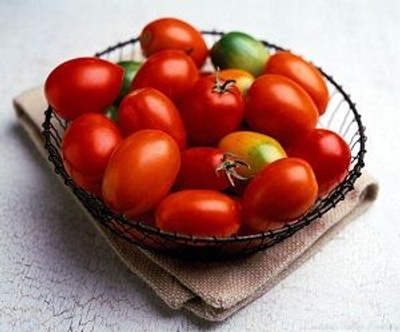Growing & using Roma Tomato
The question is not whether or not to grow Roma Tomatoes; it is how many do you grow? Roma Tomatoes are dry tomatoes so they make great sauce. Who wants watery sauce? Because they are less juicy than other tomatoes they also dry faster. And because they are meatier they also make great slicing tomatoes. They won’t cover your whopper burger, but they do go well with a slice of mozzarella and a basil leaf! The VFN means this tomato is resistant to Verticillium, Fusarium and Nematode; a very good thing indeed! Roma tomatoes are determinate which means they top out at a certain height and stop growing up. Ours get about five feet tall. Since they are a bit shorter than indeterminate varieties we find them a bit more suited for container growing.
Tomatoes are actually perennials that can’t take frost. Since most of us in the United States get frost each winter, we grow them as annuals. Perennial plants grown as annuals, like tomatoes, are an odd lot. They don’t like stress (who does?. As seedlings they often rot at the base of the stem (damp off) in response to less than desirable germination temperatures. As early transplants into a cold garden, they can go into a kind of hibernation that can be difficult to wake up from. As late transplants, they may have gotten so used to their containers that they don’t want to make a new home in new surroundings, which can make them act like dwarf varieties instead of the monsters most of them are. Sometimes older containerized plants have developed a tap root that can be easily damaged when removed from the pot. Sometimes the roots are twisted around in the container so badly that they never have a chance to become the deep tap root needed for proper growth. After all, tomatoes can develop a tap root that is five feet long---that means five feet straight down into the soil (how is your soil?). When the tap root is damaged, the tomato tends to depend more on smaller fibrous roots which give less support and can result in a poor quality plant and fruit. Soil should be well drained with plenty of organic matter.
Tomatoes are fussy about their water, too. Not only can their tap root go down five feet, but their fibrous roots can spread out just as far. Any water stress can cause numerous maladies. One of those, blossom end rot, is thought to be a lack of calcium carried into the fruit when it is just beginning to form. The calcium is carried by water. Now since growth in annuals is rapid, what may seem like just a day without water to you may be like decades to the tomato. This small dry spell can spell ugly, unusable fruit.
Not usually bothered by too many pests, tomatoes do have one foe that can take down a whole plant if not stopped. That formidable insect is a Tomato Hornworm Moth. This huge moth can get up to 5 inches across but, since it flies at night, we normally see it in the caterpillar stage on a tomato plant. The first sign that this creature has chosen your plants is the disappearance of leaves off the rib. There will also be tiny black “logs” on the rest of the plant. These were your tomato leaves at one time. Since the moth is so large we find it works well to use a cage with openings about four inches. We like concrete reinforcing wire for ours. Make them very tall and very wide, about three feet in diameter, because each bit that pokes through is a way for the caterpillar to get into the cage. Hand picking and destroy is effective also if you are consistent about monitoring your plants. As a last resort, you can also use an organic Bacillus thuringiensis which is a natural caterpillar killer.
Tomatoes have to have warm weather and warm soil to grow in. Tomato transplants should go into the garden in spring as soon as the night time temperatures are around 55 and there is no more danger of frost. A cold soggy soil will slow growth and possibly kill a young tomato plant. Soil should be well drained with plenty of organic matter. In cold spring areas, mulches can help warm up the ground and give the tomato seedlings a boost. Red Mulch has been shown to be very effective in increasing the yield of tomatoes, not only in the north, but throughout the United States. Plastic cones filled with water Season Starters also boost the temperature and with tomatoes every little bit counts.
Fertilize with an all purpose fertilizer at planting and, as the plant sets more flowers, add a vegetable fertilizer. Watering should be consistent and plentiful but soil should not become so wet that roots cannot get air. Space plants about every three feet in full sun. If flowers form on very small plants, they should be removed so the plants can make more leaves before setting fruit. The abundance of leaves helps the plant to make food and provides shade for the fruit when the sun is scorching hot.
PLEASE NOTE THAT TOMATOES MAY BE TOPPED TO ENCOURAGE BUSHINESS

